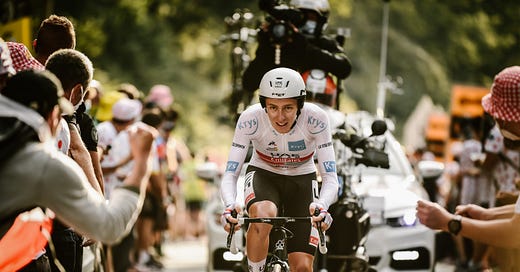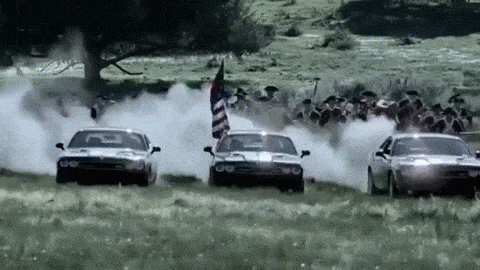This newsletter’s going out…let’s assume I write quickly…16 141 hours early, because I wanted to pay particular attention to the pivotal first time trial in the Giro d’Italia. My normal 9 a.m. Friday publishing time would’ve been in the middle of the stage, so here’s a bonus for your Thursday evening.
And in case you’re getting to it while the action’s underway, here’s the gist. The current placing of the riders I’d consider to be the major GC threats goes as follows:
Tadej Pogačar, Slovenia, UAE Emirates
Geraint Thomas, United Kingdom, Ineos Grenadiers, +46 sec.
Dani Martínez, Colombia, Bora-Hansgrohe, +47 sec.
Cian Uijtdebroeks, Belgium, Visma-Lease a Bike, +55 sec.
And then down in 11th: Ben O’Connor, Australia, Decathlon AG2R La Mondiale, +1 min. 26 sec. back. These are also the top five betting favorites, for what that’s worth.
I wanted to see how these riders had done against each other historically. Let’s take Uijtdebroeks out of the equation for now, because he’s a fetus and has no track record to speak of in time trials. He’s never raced Pogačar against the clock; he’s lost to Thomas once in last year’s Vuelta, and basically no-showed the Tirreno-Adriatico time trial against O’Connor and Martínez a couple months back.
Public opinion, as I understand it, would rank the remaining four GC threats in the following order, based on time trial ability alone:
Pogačar
Thomas
Martínez
O’Connor
For what it’s worth, that was the order of finish in Stage 1 of the 2022 Tour de France, the only time all four of these riders have taken part in the same time trial before.
But you could quibble. I think there’s an argument to be made that Thomas at his best could beat Pogačar on his day, because the young Slovenian’s reputation as a time trialist has been burnished by one or two monster outlier performances that are now a few years in the past. Martínez is also a stronger time trialist than he gets credit for, and is in my opinion the best in this discipline among his generation of South American GC guys.2
So I went back and looked at every professional individual time trial involving at least two of these four riders, dating back all the way to the 2017 Giro. And I found, well, that public opinion is more or less right. Here’s how those top four GC riders stack up against each other.
Pogačar vs. Thomas: Pogačar leads 5-2 and is faster by an average of 1.09 seconds per kilometer
Pogačar vs. Martínez: Pogačar leads 4-2 and is faster by 2.36 seconds per kilometer
Pogačar vs. O’Connor: Pogačar leads 6-0 is faster by 4.98 seconds per kilometer
Thomas vs. Martínez: Thomas leads 10-4 and is faster by 1.65 seconds per kilometer
Thomas vs. O’Connor: Thomas leads 7-3 and is faster by 0.71 seconds per kilometer
Martínez vs. O’Connor: Martínez leads 3-1 and is faster by 1.96 seconds per kilometer
So basically what we thought going in.
I wouldn’t read that much into the gaps specifically; performance in time trials is highly dependent on effort. By the end of a grand tour that can be hard to come by unless a rider’s in it for the stage win or the overall GC. For instance, about half of the gap between Pogačar and Martínez can be explained by the penultimate stage of the 2020 Tour de France, in which Pogačar rode one of the best time trials in grand tour history, while Martínez—who’d accomplished all he came to do by winning Stage 13 and cared not at all about his GC position—shipped more than three minutes despite finishing a respectable 11th.
The record between the two one-time teammates—Martínez and Thomas—is also filled with weird results and outliers. Martínez has beaten Thomas twice at early-season time trials where the Brit might not have been fully motivated, but Thomas also put five and a half minutes into Martínez in a single time trial at the 2017 Giro, which skews the seconds-per-kilometer gap between the two.
Nevertheless, we can look at these numbers as a rough guide. The time trial on Friday is 40.6 kilometers and ends with a 6.6 kilometer climb at 4.1% gradient into the finish line in Perugia.3 Keen observers will see a time trial that starts flat and ends with a 6.6 kilometer climb and think back to Pogačar’s win in 2020, but this hill is about half as steep as the Planche des Belles Filles.
Anyway, none of these guys are going to have any trouble getting up that climb. Moreover, while I think a flatter parcours would suit Thomas and a steeper one would suit O’Connor, I’m not sure how much 4.1% is going to narrow that gap.
So I feel comfortable using the gaps from Pogačar on down as a rule of thumb: one second per kilometer to Thomas, a further second and a half to Martínez, and another two and a half seconds per kilometer to O’Connor. A second and a half per kilometer is roughly the historical gap from Thomas to Martínez, and the gap from Martínez to O’Connor is about two seconds.
The only rider-to-rider comparison that doesn’t line up is O’Connor to Thomas, but that can be explained by the nature of the three times O’Connor has beaten Thomas. Those races: The prologue of the 2023 Tour Down Under, a time trial very unlike this one in a race that few European riders get particularly worked up about. Next, the 2022 Tour de Romandie—a mountain time trial that was steep enough (8.0% over 10.2 kilometers) to peg Thomas back against a pure climber like O’Connor. And finally, Stage 20 of the 2021 Tour de France. This one was long and flat, but O’Connor was embroiled in a tight four-way battle for fourth place, while Thomas had been long out of the running.
So let’s say those comparisons hold. With 40.6 kilometers on the road, I’d expect to go into the weekend with these four riders positioned as follows:
Pogačar
Thomas, +1 min. 25 sec.
Martínez, +2 min. 25 sec.
O’Connor, +6 min. 40 sec.
It’s not looking great for O’Connor’s podium hopes after the first week, and that assumes he’s working at full strength after shipping a minute to Pogačar on Stage 2. And there’s another 31 kilometers of completely flat time trial mileage coming a week from Saturday. His best chance to get back into podium position would probably be Thomas and Pogačar pulling so far away from the rest of the pack that they get fixated on each other and allow him to make a long range attack on a later mountain stage.
The good news for O’Connor is that there isn’t going to be a ton of competition storming up from behind him. The other climbers in good GC position now—Einer Rubio, Lorenzo Fortunato, Jan Hirt—aren’t great time trialists either. Aleksey Lutsenko is the only direct O’Connor competitor who I’d expect to put serious time into the Australian, and O’Connor can outclimb Lutsenko later in the race.
The one real far-out left-field dark horse, etc., etc., contender I’d look out for is Luke Plapp. The 23-year-old is a two-time Australian national time trial champion, and while he’s only ever raced one grand tour before, he does have a handful of top-10 GC finishes in one-week World Tour stage races. That includes second at last year’s UAE Tour and sixth at this year’s Paris-Nice.
We’ll see how much juice Plapp has in his legs 24 hours after he spent 91 kilometers in a fast breakaway on Stage 6. Plapp didn’t win the stage, but he did manage to stay in the leading group and gain more than 30 seconds on the GC group. He’s now in 15th place, just 31 seconds behind O’Connor and a minute and 10 seconds behind Martínez.
Unless Plapp completely dogs it, I’d be astonished if he didn’t overtake O’Connor4, and it wouldn’t be the shock of a lifetime if he ended the day in the top five on GC. At that point, he’d be the top Jayco-Alula rider with a third of the race behind him.
If he can hang on through Saturday’s stage, which features three categorized climbs and ends at Prati di Tivo, maybe we can talk about top 10 on GC for Plappy. We’ll just have to watch. Or, we can record it on our our Prati di TiVo.
I’ve been waiting all race to make that joke. Please like, subscribe, and share.
There is also a stage win on the line, so let’s talk about that real quick as well. I think that hill at the end is going to be tough for Filippo Ganna, but that enormous bastard has surprised me before. I don’t hate it for Mikkel Bjerg, the three-time world junior time trial champ who’s been one of Pogačar’s key assistants on lower pitches of climbs. Bjerg hasn’t been anything like that quality of time trialist as a senior pro, but it’s an odd field and an odd parcours.
If Ganna can’t get up the final climb quickly, I bet his teammate Tobias Foss will have better luck. But since we’re talking about Ineos, you know where this is going.
That’s right, Magnus Sheffield.
There are plenty of reasons to be skeptical. He put in a big turn on Stage 6 hauling Thomas up the gravel sections, and even if he’s not gassed from his effort on Thursday Ineos might ask him to hold back and leave something in the tank for later in the race. He also has a maddening propensity for crashing.
But I feel this one in my bones, friends. Magnus Sheffield: Grand tour stage winner. It’s so close I can taste it. And it tastes like liberty.
“Yeah, I can knock this out in like an hour,” I said to myself. Because I’m the stupidest boy on the planet.
Egan Bernal, Richard Carapaz, Miguel Ángel López if you want to count him
I’m currently replaying Mass Effect 2, in which “Perugia” is a password you have to steal in order to break into the vault of nefarious spacefaring Afrikaner Donovan Hock on one of the side quests. I’m going to bring that up every time the city is mentioned for the rest of my life, no matter how boring that bit of trivia is.
If only temporarily







Bravo di TiVo